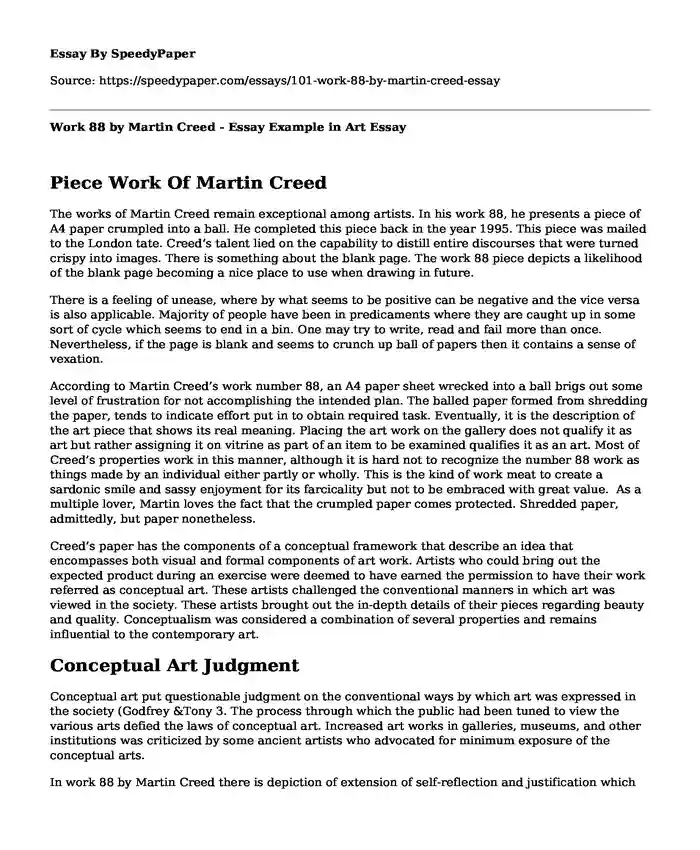Piece Work Of Martin Creed
The works of Martin Creed remain exceptional among artists. In his work 88, he presents a piece of A4 paper crumpled into a ball. He completed this piece back in the year 1995. This piece was mailed to the London tate. Creed’s talent lied on the capability to distill entire discourses that were turned crispy into images. There is something about the blank page. The work 88 piece depicts a likelihood of the blank page becoming a nice place to use when drawing in future.
There is a feeling of unease, where by what seems to be positive can be negative and the vice versa is also applicable. Majority of people have been in predicaments where they are caught up in some sort of cycle which seems to end in a bin. One may try to write, read and fail more than once. Nevertheless, if the page is blank and seems to crunch up ball of papers then it contains a sense of vexation.
According to Martin Creed’s work number 88, an A4 paper sheet wrecked into a ball brigs out some level of frustration for not accomplishing the intended plan. The balled paper formed from shredding the paper, tends to indicate effort put in to obtain required task. Eventually, it is the description of the art piece that shows its real meaning. Placing the art work on the gallery does not qualify it as art but rather assigning it on vitrine as part of an item to be examined qualifies it as an art. Most of Creed’s properties work in this manner, although it is hard not to recognize the number 88 work as things made by an individual either partly or wholly. This is the kind of work meat to create a sardonic smile and sassy enjoyment for its farcicality but not to be embraced with great value. As a multiple lover, Martin loves the fact that the crumpled paper comes protected. Shredded paper, admittedly, but paper nonetheless.
Creed’s paper has the components of a conceptual framework that describe an idea that encompasses both visual and formal components of art work. Artists who could bring out the expected product during an exercise were deemed to have earned the permission to have their work referred as conceptual art. These artists challenged the conventional manners in which art was viewed in the society. These artists brought out the in-depth details of their pieces regarding beauty and quality. Conceptualism was considered a combination of several properties and remains influential to the contemporary art.
Conceptual Art Judgment
Conceptual art put questionable judgment on the conventional ways by which art was expressed in the society (Godfrey &Tony 3. The process through which the public had been tuned to view the various arts defied the laws of conceptual art. Increased art works in galleries, museums, and other institutions was criticized by some ancient artists who advocated for minimum exposure of the conceptual arts.
In work 88 by Martin Creed there is depiction of extension of self-reflection and justification which lacks in the crunch up drawing. Many artists since the ancient times have questioned how their art has been viewed and the criticism they have received. These artists have tried to come up with the supporting arguments that their work has attained the quality of being categorized as conceptual art. The work 88 by Creed has the feature of radical dematerialization which further supports it as an acceptable conceptual art unlike the crunch up paper. Dematerialization involved the artist becoming simplistic in their endeavors. Simplicity in the work 88 is a general view by everyone.
Conceptual artists also associate their works to a tradition of anti-aesthetic work which has the greatest exponent (Kranjec 22). The art analysis that was pursued by the conceptual artists such as Martin Creed in his piece made them have a belief that the artist had conveyed their message to the projected audience. Creed ensured that the piece was captivating tot the intended audiences. The crunch up par does not have details such as these that support its conceptualism.
To show the flexibility of his works, Creed folded and unfolded a sheet of paper in a way that was seen as a pessimistic visitation of previous ideas that were that encompassed things that were an appeal to do something. The message was conveyed in the drawing yet none of the other artists of his times could have imagined that such a drawing would become a magnificent piece that would be used in the art world. The article brings to mind that there is fear of the existing blank page. The piece is also unique from other works of the artist such as the work 340. The work 88 brings into mind of the viewer that the paper folding practice transforms the unseen perception of beauty of the folded paper. Not many artists can deliver the art in such a simplified form as done by Martin.
Works Cited
Austin Considine,. Art In America (2016) Retrieved From: Godfrey, Tony. Conceptual art. Phaidon Press, 1998.
http://www.artinamericamagazine.com/reviews/martin-creed/
http://www.saylor.org/site/wp-content/uploads/2012/02/ARTH408-2.3.2-Justin-Wolf%E2%80%99s-Conceptual-Art.pdf
Justin Wolf..,Conceptual Art (2012) Retrieved From:
Kranjec, Alexander. "Conceptual art made simple for neuroaesthetics." Frontiers in human neuroscience 9 (2015).
Martin Creed, Work No. 88, A sheet of A4 paper crumpled into a ball, 1995
Cite this page
Work 88 by Martin Creed - Essay Example in Art. (2018, Aug 10). Retrieved from https://speedypaper.net/essays/101-work-88-by-martin-creed-essay
Request Removal
If you are the original author of this essay and no longer wish to have it published on the SpeedyPaper website, please click below to request its removal:
- Infant Experiment Essay Sample
- Pessimism Definition Essay Sample
- Check the Mock Job Interview in the Free Essay Example
- Comparative Political Economy, Free Essay
- Free Essay with the Sleepy Hollow Movie Review
- Free Research Paper Sample on Human Marine Activities
- Ethical Politics, Free Essay for You to Check
Popular categories





